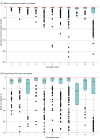Characterization of Transplant Center Decisions to Allocate Kidneys to Candidates With Lower Waiting List Priority
- PMID: 37273203
- PMCID: PMC10242426
- DOI: 10.1001/jamanetworkopen.2023.16936
Characterization of Transplant Center Decisions to Allocate Kidneys to Candidates With Lower Waiting List Priority
Abstract
Importance: Allocation of deceased donor kidneys is meant to follow a ranked match-run list of eligible candidates, but transplant centers with a 1-to-1 relationship with their local organ procurement organization have full discretion to decline offers for higher-priority candidates and accept them for lower-ranked candidates at their center.
Objective: To describe the practice and frequency of transplant centers placing deceased donor kidneys with candidates who are not the highest rank at their center according to the allocation algorithm.
Design, setting, and participants: This retrospective cohort study used 2015 to 2019 organ offer data from US transplant centers with a 1-to-1 relationship with their local organ procurement organization, following candidates for transplant events from January 2015 to December 2019. Participants were deceased kidney donors with a single match-run and at least 1 kidney transplanted locally and adult, first-time, kidney-only transplant candidates receiving at least 1 offer for a locally transplanted deceased donor kidney. Data were analyzed from March 1, 2022 to March 28, 2023.
Exposure: Demographic and clinical characteristics of donors and recipients.
Main outcomes and measures: The outcome of interest was kidney transplantation into the highest-priority candidate (defined as transplanted after zero declines for local candidates in the match-run) vs a lower-ranked candidate.
Results: This study assessed 26 579 organ offers from 3136 donors (median [IQR] age, 38 [25-51] years; 2903 [62%] men) to 4668 recipients. Transplant centers skipped their highest-ranked candidate to place kidneys further down the match-run for 3169 kidneys (68%). These kidneys went to a median (IQR) of the fourth- (third- to eighth-) ranked candidate. Higher kidney donor profile index (KDPI; higher score indicates lower quality) kidneys were less likely to go to the highest-ranked candidate, with 24% of kidneys with KDPI of at least 85% going to the top-ranked candidate vs 44% of KDPI 0% to 20% kidneys. When comparing estimated posttransplant survival (EPTS) scores between the skipped candidates and the ultimate recipients, kidneys were placed with recipients with both better and worse EPTS than the skipped candidates, across all KDPI risk groups.
Conclusions and relevance: In this cohort study of local kidney allocation at isolated transplant centers, we found that centers frequently skipped their highest-priority candidates to place kidneys further down the allocation prioritization list, often citing organ quality concerns but placing kidneys with recipients with both better and worse EPTS with nearly equal frequency. This occurred with limited transparency and highlights the opportunity to improve the matching and offer algorithm to improve allocation efficiency.
Conflict of interest statement
Figures




